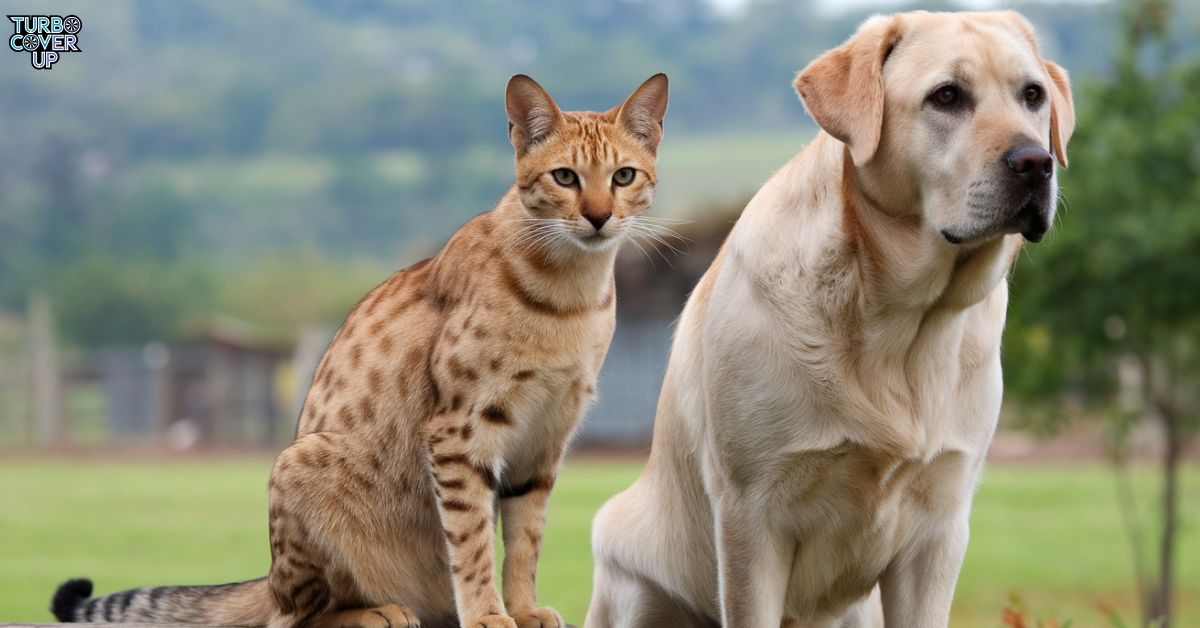Unique Traits of Savannah Cats
Savannah cats are a fascinating blend of wild and domestic. They’re a sight to behold, born from the union of a house cat and an African Serval. These cats are tall, lean, and spotted, turning heads wherever they go.
- Scientific name: Felis catus × Leptailurus serval
- Lifespan: 12-20 years
- Weight: 12-25 pounds
- Exercise: High
- Hypoallergenic: No
Savannah cat personality is as unique as their appearance. They’re smart, active, and often act more like dogs than cats. This active engaging pet will keep you on your toes.
Their high energy levels mean they need lots of playtime and exercise. If you’re looking for a lazy lap cat, a Savannah might not be your best bet. But if you want a lively companion, you’ve hit the jackpot.
How Big Do Savannah Cats Get?
When it comes to size, Savannah cats are in a league of their own. They’re not your average house cat – these felines can grow to be quite large.
Well, it varies. Savannah cat size can range from medium to large. On average, they weigh between 12 and 25 pounds. Some can even reach heights of up to 17 inches at the shoulder.
Several factors play into a Savannah’s size. Their generation, genetics, and diet all have a role. F1 generation Savannahs, being closest to their wild ancestors, tend to be the largest. As you move down the generations, the size usually decreases.
What’s the difference between F1, F2, F3, F4, and F5 Savannah cats?
Understanding Savannah cat generations is key to grasping their size differences. The “F” stands for filial, and the number shows how far removed they are from their serval ancestry.
F1 Savannah cats are the offspring of a serval and a domestic cat. They’re the largest and most wild-like. F2s are the children of F1s, F3s of F2s, and so on. With each generation, the size and wild traits generally decrease.
It’s not just size that changes across generations. Personality traits can vary too. Early generations often show more wild behaviors, while later ones may be more domestic. Price and availability also differ, with F1s being the rarest and most expensive.
Savannah Cat Size Compared To Different Dog Breeds
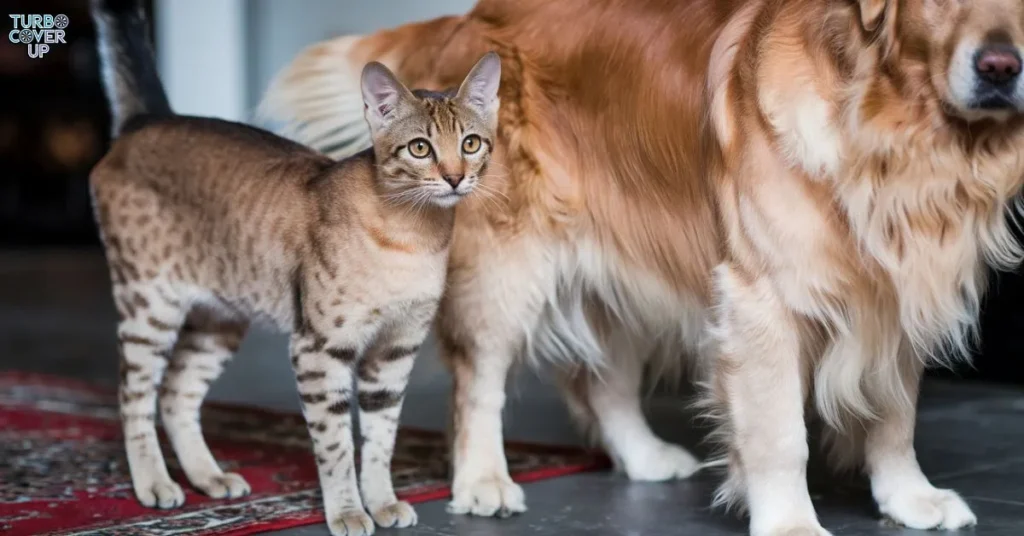
Compared to small dog breeds like Chihuahuas or Yorkshire Terriers, even the smallest Savannahs are giants. They’re more on par with medium-sized dogs. Think Beagles or Cocker Spaniels. Some larger Savannahs might even match up to smaller Labrador Retrievers.
Despite their size, Savannah cats are known for their agility and athleticism, which is comparable to breeds like Border Collies and Australian Shepherds. Their muscular build and strong instincts make them excellent hunters and climbers, like Huskies or Weimaraners.
It’s important to note that while Savannahs can be as tall as some medium dogs, they’re usually leaner. Their long legs and sleek bodies give them a unique shape that’s all their own. This cat breed size comparison shows just how special Savannahs are.
Why Are Savannah Cats Comparable to Dogs in Size?
The impressive size of Savannah cats isn’t just a quirk of nature. It’s the result of careful breeding and their wild heritage. Their serval ancestry plays a big role in their size.
African Servals are much larger than domestic cats. When bred with house cats, they pass on some of that size. Breeders have also been selected for larger cats over time, enhancing this trait. This Savannah hybrid truly brings together the best of both worlds.
Diet and exercise also play a part. Savannahs need high-quality food and lots of activity to reach their full-size potential. Their muscular build comes from their high energy and love of play. This combination of genetics and lifestyle makes them comparable to dogs in size.
The Factors Influencing The Size Of Savannah Cats
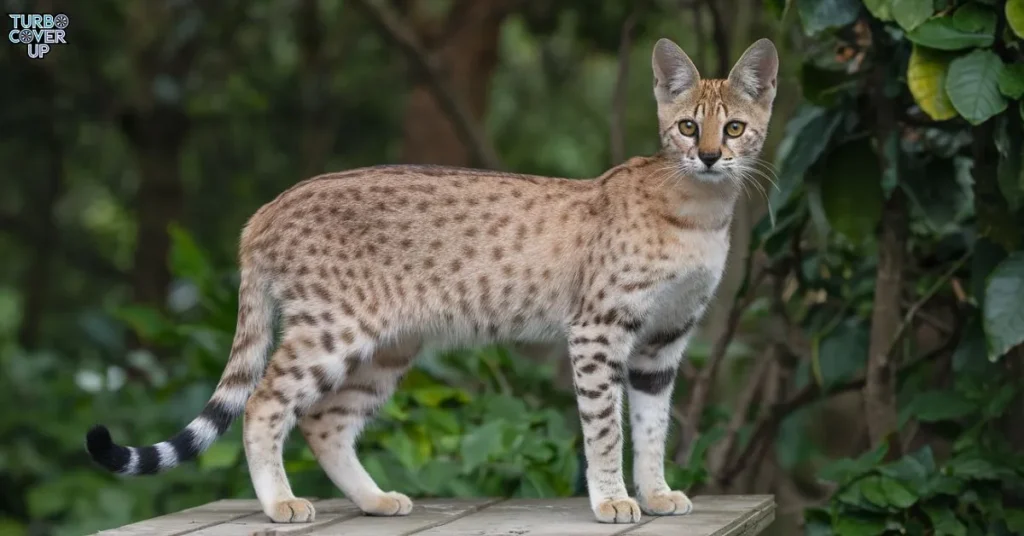
Several factors come into play when determining the size of a Savannah cat. First and foremost is genetics. The percentage of serval genetics in a Savannah has a direct impact on its size. Generally, the higher the percentage, the larger the cat.
Diet and nutrition also play a crucial role. Savannahs need a high-protein diet to support their growth and maintain their muscular build. Poor nutrition can stunt their growth and affect their overall health.
Exercise and activity levels are equally important. These high energy cats need plenty of physical activity to develop properly. A sedentary lifestyle can lead to obesity, which can make a Savannah appear larger, but not in a healthy way.
What other traits do Savannah cats possess that resemble those of dogs?
It’s not just size that makes Savannah cats similar to dogs. Their behavior often mimics canine traits too. For starters, they’re incredibly intelligent and trainable. Many Savannah owners report teaching their cats tricks, just like dogs.
Their social nature is another dog-like trait. Savannah cat personality tends to be very people-oriented. They crave interaction and can become lonely if left alone for long periods. This need for social interaction is more commonly associated with dogs than cats.
Loyalty is another characteristic that sets Savannahs apart. They often form strong bonds with their owners, following them around the house and greeting them at the door. This level of devotion is reminiscent of our canine friends.
Playfulness of Savannah Cats
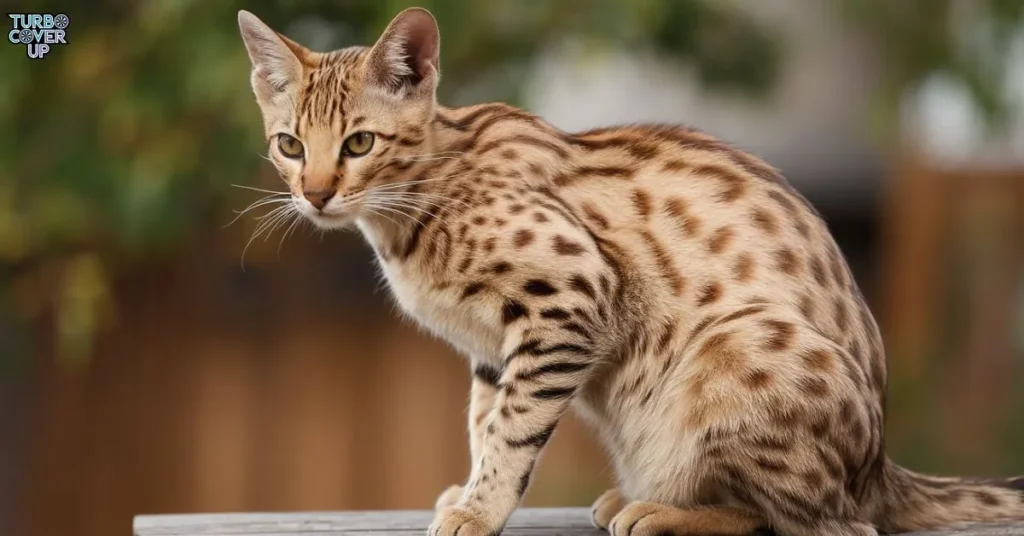
The playfulness of Savannah cats is legendary. These active engaging pets have energy to spare and a love for fun that never seems to quit. They’re not content to just bat at a dangling string – Savannahs need interactive, challenging play.
Many Savannah owners find their cats enjoy fetch, just like dogs. They’ll chase after toys and bring them back, ready for another round. Puzzle toys are also a hit, as these smart cats love to problem-solve. Their play often involves impressive acrobatics, leaping high into the air or scaling tall cat trees.
This playful nature isn’t just for fun – it’s crucial for their well-being. Exercise required for Savannah cat is significant. Without enough play and activity, they can become bored and potentially destructive. Providing plenty of toys and play sessions is key to keeping a Savannah happy and healthy.
Walking on a Leash for Savannah Cat
Savannah cats can be trained to walk on a leash. This dog-like behavior is another way these unique felines blur the line between cat and canine. Walking your Savannah can be a great way to provide exercise and mental stimulation.
Starting leash training early is key. Introduce the harness gradually, letting your cat get used to wearing it indoors first. Once they’re comfortable, you can attach the leash and practice inside. Patience is crucial – some cats take to it quickly, while others need more time.
Remember, walking a Savannah isn’t quite like walking a dog. They may want to climb trees or investigate interesting smells. Always prioritize safety, keeping an eye out for potential hazards. With practice, leash walks can become a fun activity for both you and your Savannah.
Loyalty of Savannah Cats
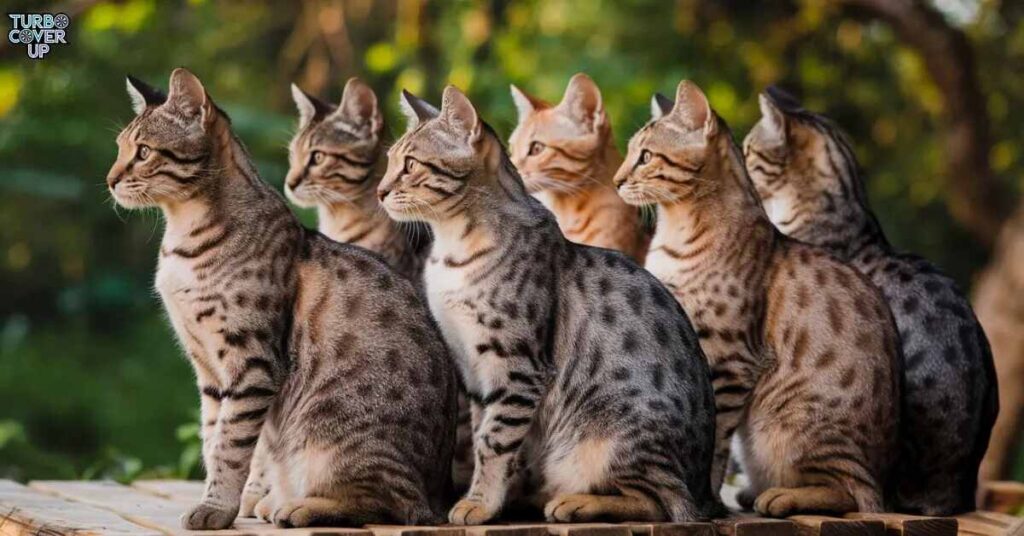
The loyalty of Savannah cats is often compared to that of dogs. These felines form strong bonds with their human families, showing a level of devotion that’s unusual in the cat world. It’s one of the many unique traits of Savannah cat that endear them to their owners.
Savannahs often follow their favorite people from room to room, always wanting to be part of the action. They may greet you at the door when you come home, or snuggle up next to you on the couch. This constant companionship is more typically associated with dogs than cats.
However, it’s important to note that this loyalty comes with responsibility. Savannahs need lots of attention and interaction. They don’t do well when left alone for long periods. If you’re looking for an independent cat that’s happy to be left to its own devices, a Savannah might not be the best choice.
The World’s Tallest Domestic Cat
When we talk about Savannah cat size, we can’t ignore the record holders. As of 2024, the Guinness World Record for the tallest domestic cat belongs to a Savannah named Fenrir. This impressive feline stands at a whopping 18.83 inches tall!
Fenrir’s size is exceptional, even for a Savannah. He’s an F2 generation, meaning his grandfather was a serval. This close serval ancestry contributes to his impressive stature. However, it’s important to remember that not all Savannahs will grow this large.
The existence of cats like Fenrir shows the potential for size in the Savannah breed. However, most Savannahs will be smaller. Factors like genetics, diet, and individual growth patterns all play a role in determining a cat’s final size.
Distinctive features of Savannah cats
Savannah cats are known for their distinctive appearance. Their large, upright ears are one of their most noticeable features. These ears aren’t just for show – they’re highly functional, giving Savannahs excellent hearing.
The coat of a Savannah is another standout feature. They typically have a short, dense coat with bold spots or stripes. This pattern is a throwback to their serval ancestry. The base color can vary, but most Savannahs are some shade of golden or silver with black spots.
Their body structure is unique among domestic cat breeds. Savannahs are tall and lean, with long legs that give them an almost cheetah-like appearance. Their faces are more angular than typical house cats, with high cheekbones and slightly hooded eyes.
Reproduction and genetics of Savannah Cats
The reproduction and genetics of Savannah cats is a complex topic. Breeding Savannahs, especially in the early generations, can be challenging due to hybrid infertility. Male F1 and F2 Savannahs are often sterile, which affects breeding programs.
Genetically, Savannahs inherit traits from both their serval and domestic cat ancestors. This mix results in their unique appearance and personality traits. The percentage of serval genetics decreases with each generation, which is why F1 Savannahs tend to be larger and more “wild” in appearance than later generations.
Litter sizes for Savannahs are typically smaller than those of domestic cats, especially in the early generations. F1 Savannahs might only have 1-2 kittens per litter, while later generations may have slightly larger litters. This, combined with the breeding challenges, contributes to the rarity and high cost of Savannah cats.
Health Considerations for Savannah Cats
When it comes to health, Savannah cats have some unique considerations. Their large size can put extra stress on their joints, potentially leading to issues like hip dysplasia. This is more common in the larger, early generation Savannahs.
Diet is crucial for maintaining Savannah cat health. They need a high-protein diet to support their muscular build and high energy levels. Some owners opt for raw diets, while others choose high-quality commercial cat foods. Consult with a vet to determine the best diet for your Savannah.
Regular exercise is also key to keeping Savannahs healthy. Their high energy levels mean they need plenty of opportunities to run, climb, and play. Without adequate exercise, they can become overweight or develop behavioral issues. Providing a stimulating environment with plenty of toys and climbing spaces is essential.
Savannah Cat Size Comparison to Dog
When comparing Savannah cat size to dogs, it’s helpful to look at some specific numbers. Here’s a comparison chart:
| Animal | Average Weight | Average Height (at shoulder) |
| Savannah Cat (F1-F3) | 15-25 lbs | 14-17 inches |
| Savannah Cat (F4+) | 10-18 lbs | 12-15 inches |
| Chihuahua | 3-6 lbs | 6-9 inches |
| Beagle | 20-30 lbs | 13-15 inches |
| Cocker Spaniel | 20-30 lbs | 14-15 inches |
| Labrador Retriever | 55-80 lbs | 21-24 inches |
Size Comparison: Savannah Cats vs. Other Domestic Cats
When we look at Savannah cat size compared to other domestic cat breeds, the difference can be striking. Let’s break it down:
Maine Coons are often called the gentle giants of the cat world. They can weigh up to 18 pounds and reach lengths of up to 40 inches. Savannahs, especially F1 and F2 generations, can often match or exceed this size. However, Savannahs tend to be leaner and more muscular.
Ragdolls are another large domestic cat breed, known for their fluffy coats. They typically weigh between 10-20 pounds. While they might match Savannahs in weight, their body structure is quite different. Savannahs are tall and lean, while Ragdolls are long and stocky.
Bengal cats, another hybrid breed with wild ancestry, are closer in appearance to Savannahs. However, they’re generally smaller, typically weighing between 8-15 pounds. The larger size of Savannahs, especially in early generations, sets them apart.
Savannah Cat Breeding and Litter Sizes
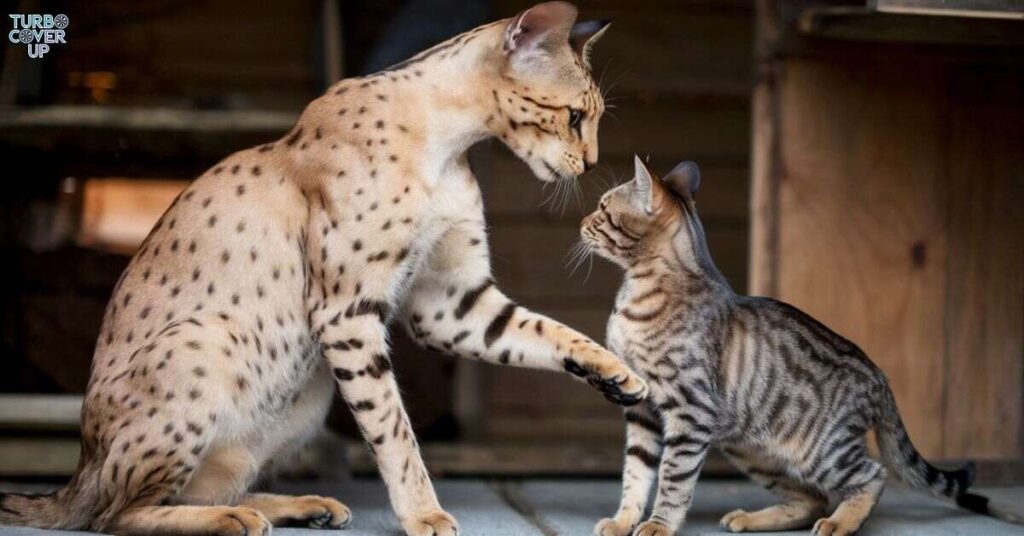
Savannah cat breeding is a complex process, especially for early generations. F1 Savannahs are the result of breeding a serval with a domestic cat, which can be challenging due to size differences and behavioral incompatibilities.
Litter sizes for Savannahs tend to be smaller than those of typical domestic cats. F1 and F2 Savannahs might only have 1-2 kittens per litter. As you move down the generations, litter sizes may increase slightly, but they’re still generally smaller than average.
The gestation period for Savannahs is the same as for domestic cats, about 65 days. However, due to their larger size, Savannah kittens may take longer to fully mature. It’s crucial for breeders to ensure kittens stay with their mother for an appropriate amount of time for proper socialization and development.
Savannah Cat Coat Colors and Patterns
The coat of a Savannah cat is one of its most striking features. The standard coat pattern is spotted, a throwback to their serval ancestry. These spots can be round, oval, or elongated, creating a wild and exotic look.
When it comes to colors, Savannahs come in a variety of shades. The most common is a warm golden color with black spots, similar to a serval. However, you might also see silver Savannahs with black spots, or even black Savannahs with barely visible spots.
- Brown Spotted Tabby = Aguoti Cat (A-)
- Silver Spotted Tabby = Aguoti Cat (A-) + Inhibitor gene
- Black = Non-Aguoti Cat (AA)
- Smoke = Non-Aguoti Cat (AA) + Inhibitor gene
It’s worth noting that coat color and pattern can affect how large a Savannah appears. Darker colors and larger spots can make a cat look bigger, while lighter colors and smaller spots might make them appear more delicate. This optical illusion adds another layer to the Savannah cat size discussion.
Savannah Cats: Myths and the Truth
There are many myths surrounding Savannah cats, particularly about their size and behavior. Let’s separate fact from fiction:
Myth: Savannah cats are as big as tigers.
Truth: While Savannahs are large for domestic cats, they’re nowhere near tiger-sized. Even the largest F1 Savannahs are only about the size of a medium dog.
Myth: Savannah cats are dangerous like wild animals.
Truth: Savannah cat personality is generally friendly and sociable. While they have wild ancestry, they’re bred to be domestic pets and are not inherently dangerous.
Myth: All Savannah cats are huge.
Truth: Savannah cat size varies greatly depending on generation and individual genetics. Later generations (F4 and beyond) are often closer in size to large domestic cats.
What are the potential health conditions for Savannah cats?
Like all breeds, Savannah cats can be prone to certain health issues. Their large size can sometimes lead to joint problems, particularly in the hips and knees. Regular check-ups with a vet experienced in exotic breeds is important.
Some Savannahs may be prone to hypertrophic cardiomyopathy, a heart condition found in many cat breeds. This is why health screening of breeding cats is crucial. Their high energy levels also mean they need a diet rich in protein and nutrients to stay healthy.
Lastly, due to their hybrid nature, some Savannahs may be more susceptible to certain feline viruses. It’s important to keep them up to date on vaccinations and to be aware of any breed-specific health concerns. Always consult with a vet familiar with Savannah cats for the best advice on keeping your exotic pet healthy.
Frequently Asked Questions
How big are Savannah cats?
Savannah cats can weigh between 8 to 25 pounds and stand tall with long, lean bodies.
Is a Savannah cat like a dog?
Yes, Savannah cats have dog-like traits. They enjoy playing fetch and can be trained to walk on a leash.
Why are Savannah cats so big?
Their size comes from being bred with wild African Servals, which are naturally larger cats.
Do Savannah cats get along with other pets?
They can, but early socialization is important for them to get along with other pets.
Are Savannah cats good with kids?
Yes, they are generally friendly and active, making them a fun companion for children.
Do Savannah cats need a lot of attention?
Yes, they are energetic and require plenty of playtime and interaction to stay happy.
How long do Savannah cats live?
Savannah cats typically live between 12 to 20 years with proper care and attention.
Are Savannah cats legal to own everywhere?
No, some places have restrictions on owning Savannah cats due to their wild ancestry.
Do Savannah cats shed a lot?
They shed moderately, but regular grooming helps manage the shedding.
How active are Savannah cats?
Savannah cats are very energetic and need plenty of exercise and mental stimulation.
Can Savannah cats be left alone for long periods?
No, they can get bored and lonely, so it’s best not to leave them alone for too long.
Conclusion
Savannah cats are a mix of house cats and wild African Servals, known for their large size and dog-like traits. They can weigh between 10 to 25 pounds and their tall, lean bodies make them stand out. These active, playful cats love to be around people and even enjoy playing fetch or walking on a leash. Compared to small and medium dogs, Savannahs are similar in size but more agile. Their unique appearance, loyalty, and high energy make them a special choice for pet owners looking for a lively companion.
Read More:

